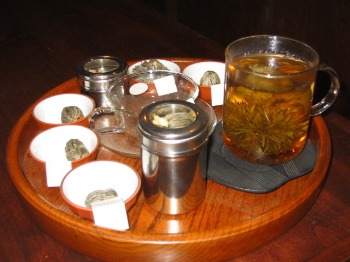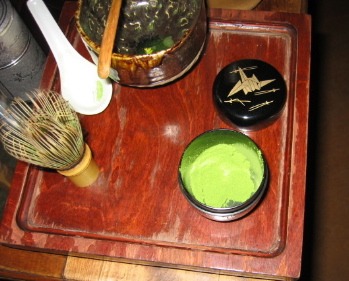I attended another slow food activity tonight. It was a tea tasting or should I say a tea discovery. It was held at the Maison de Thé Camellia Sinensis. I had walked by it before but had never gone inside because it seemed dark and empty, so it was a pleasant surprise when I walked in to see lots of people and to discover three completely different rooms, one is the store and boasts beautiful silver containers along one wall and a collection of tea pots along the other.
The next room is a regular café style and the third is set up like a Japanese teahouse. The owners travel the world to buy their teas directly from the producers, and preferably from owner-operated farms, which do not use pesticides or chemicals, so there are very knowledgeable about the teas they sell.
For this event, they had set up three “stations” representing three tea producing countries: India (Darjeeling), Japan and China (including Taiwan). At each station we were introduced to the varieties of teas grown in that country as well as the methods used to collect and store the teas. We also got to taste several teas from each region.
We were told there are 3 kinds of teas: white, green and black. White is very mild and owes its colour to the presence of many buds in the tea. There is more than one harvest every year and each one produces a different quality of leaves. The methods of handling the leaves also influences the quality of the tea: how they are picked and dried.
Then there are rules to preparing the drink. The ideal temperature of the water is not the same for all teas. Black tea requires the hottest water but such hot water would harm the delicate white teas. The Japanese tea does not require extremely hot water either.
In the oriental tradition you need 2 teapots one to steep and one to pour the prepared tea into. So you boil the water, then you pour a little of that water into both tea pots to warm them up, then you throw that water away, You then put your tea, either loose or in a holder that is big enough not to crush the leaves (bamboo ones are very good) and you pour the hot water over them. Pouring from far up is good because it oxygenates the water…. You let steep a few minutes and then you transfer the ready tea to the second teapot from which you can serve. It is suggested that you only serve one kind of tea per teapot and that you NEVER use soap to wash a teapot…. so that the pot acquires the flavour and transfers it back to the tea.
I was intrigued by something that resembled a sea anemone in a glass cup of tea. It was a variety of jasmine tea that is tied up in a bunch and spreads open when submerged. It was so pretty I bought some…now I need to find a clear glass cup…
The other thing that surprised me was the Japanese tea ceremony. It is a very lengthy ritual. We only got a short version. They use green powdered tea and whisk it up to a frothy mix with a bamboo whisk that resembles those old fashion shaving brush but is much stiffer. I bought some of that powdered tea to make tea ice cream.
If you want to find out more about this tea house check out their website:



